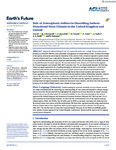Role of Atmospheric Indices in Describing Inshore Directional Wave Climate in the United Kingdom and Ireland
| dc.contributor.author | Scott, Tim | |
| dc.contributor.author | McCarroll, Jak | |
| dc.contributor.author | Masselink, Gerd | |
| dc.contributor.author | Castelle, B | |
| dc.contributor.author | Dodet, G | |
| dc.contributor.author | Saulter, A | |
| dc.contributor.author | Scaife, AA | |
| dc.contributor.author | Dunstone, N | |
| dc.date.accessioned | 2021-05-17T08:22:22Z | |
| dc.date.available | 2021-05-17T08:22:22Z | |
| dc.date.issued | 2021-05 | |
| dc.identifier.issn | 2328-4277 | |
| dc.identifier.issn | 2328-4277 | |
| dc.identifier.other | e2020EF001625 | |
| dc.identifier.uri | http://hdl.handle.net/10026.1/17121 | |
| dc.description.abstract |
<jats:title>Abstract</jats:title><jats:p>Improved understanding of how our coasts will evolve over a range of time scales (years‐decades) is critical for effective and sustainable management of coastal infrastructure. A robust knowledge of the spatial, directional and temporal variability of the inshore wave climate is required to predict future coastal evolution and hence vulnerability. However, the variability of the inshore directional wave climate has received little attention, and an improved understanding could drive development of skillful seasonal or decadal forecasts of coastal response. We examine inshore wave climate at 63 locations throughout the United Kingdom and Ireland (1980–2017) and show that 73% are directionally bimodal. We find that winter‐averaged expressions of six leading atmospheric indices are strongly correlated (<jats:italic>r</jats:italic> = 0.60–0.87) with both total and directional winter wave power (peak spectral wave direction) at all studied sites. Regional inshore wave climate classification through hierarchical cluster analysis and stepwise multi‐linear regression of directional wave correlations with atmospheric indices defined four spatially coherent regions. We show that combinations of indices have significant skill in predicting directional wave climates (<jats:italic>R</jats:italic><jats:sup><jats:italic>2</jats:italic></jats:sup> = 0.45–0.8; <jats:italic>p</jats:italic> < 0.05). We demonstrate for the first time the significant explanatory power of leading winter‐averaged atmospheric indices for directional wave climates, and show that leading seasonal forecasts of the NAO skillfully predict wave climate in some regions.</jats:p> | |
| dc.format.extent | e2020EF001625- | |
| dc.format.medium | Print-Electronic | |
| dc.language | en | |
| dc.language.iso | en | |
| dc.publisher | American Geophysical Union (AGU) | |
| dc.subject | climate indices | |
| dc.subject | coastal evolution | |
| dc.subject | inshore wave climate | |
| dc.subject | long term prediction | |
| dc.subject | seasonal forecasting | |
| dc.subject | wave direction | |
| dc.title | Role of Atmospheric Indices in Describing Inshore Directional Wave Climate in the United Kingdom and Ireland | |
| dc.type | journal-article | |
| dc.type | Journal Article | |
| plymouth.author-url | https://www.webofscience.com/api/gateway?GWVersion=2&SrcApp=PARTNER_APP&SrcAuth=LinksAMR&KeyUT=WOS:000656968900010&DestLinkType=FullRecord&DestApp=ALL_WOS&UsrCustomerID=11bb513d99f797142bcfeffcc58ea008 | |
| plymouth.issue | 5 | |
| plymouth.volume | 9 | |
| plymouth.publisher-url | http://onlinelibrary.wiley.com/journal/10.1002/(ISSN)2328-4277 | |
| plymouth.publication-status | Published | |
| plymouth.journal | Earth's Future | |
| dc.identifier.doi | 10.1029/2020ef001625 | |
| plymouth.organisational-group | /Plymouth | |
| plymouth.organisational-group | /Plymouth/Faculty of Science and Engineering | |
| plymouth.organisational-group | /Plymouth/Faculty of Science and Engineering/School of Biological and Marine Sciences | |
| plymouth.organisational-group | /Plymouth/REF 2021 Researchers by UoA | |
| plymouth.organisational-group | /Plymouth/REF 2021 Researchers by UoA/UoA07 Earth Systems and Environmental Sciences | |
| plymouth.organisational-group | /Plymouth/Research Groups | |
| plymouth.organisational-group | /Plymouth/Research Groups/Marine Institute | |
| plymouth.organisational-group | /Plymouth/Users by role | |
| plymouth.organisational-group | /Plymouth/Users by role/Academics | |
| plymouth.organisational-group | /Plymouth/Users by role/Researchers in ResearchFish submission | |
| dc.publisher.place | United States | |
| dcterms.dateAccepted | 2021-04-05 | |
| dc.rights.embargodate | 2021-5-18 | |
| dc.identifier.eissn | 2328-4277 | |
| dc.rights.embargoperiod | Not known | |
| rioxxterms.versionofrecord | 10.1029/2020ef001625 | |
| rioxxterms.licenseref.uri | http://www.rioxx.net/licenses/all-rights-reserved | |
| rioxxterms.licenseref.startdate | 2021-05 | |
| rioxxterms.type | Journal Article/Review | |
| plymouth.funder | Physical and biological dynamic coastal processes and their role in coastal recovery (BLUE-coast)::NERC |


